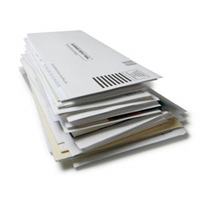On April 6th Royal Mail's rate change will mean that users of franking machine technology can save up to 7p on every mailed item (5p on first-class items) compared with using stamps. Royal Mail is able to offer this kind of discount because franked mail is more efficient to handle and process. For small businesses there has never been a bigger incentive to reassess mailing practices and investigate the latest automated technologies.
Saving time and money
When it comes to communicating with customers and prospects, many small businesses still adopt time-consuming, manual techniques that are inefficient and expensive. Indeed, these manual techniques are often conducted by senior management and/or business owners - staff whose time could be better focused on other critical tasks. Consider the time spent buying stamps, folding documents, even licking and sealing envelopes.
Too often, the mailing function is overlooked when it comes to technology and investment. Small businesses regard time and money spent focusing on computer and IT support as essential. And yet, what business function could be more commonplace - or more critical - than customer communications?
Technology is available to automate every step of the mailing cycle - from folding and inserting the document, to automatically adding postage through to accurately printing addresses. In this way, the customer communications process can transform from being regarded as a necessary burden, to become an efficient function that drives customer loyalty and business growth.
Aside from freeing-up staff to focus on their core jobs, automating these mailing processes can deliver savings of at least 12% on postage costs - a compelling figure at a time when budgets continue to be squeezed.
Further return on investment comes from producing accurate mailings. The latest address management tools and printers ensure the right message reaches the right person, eliminating wastage and increasing the selling opportunity.
Making the message stick
Today's analysts estimate that the typical consumer is exposed to between 1-4,000 marketing messages every day. This figure at first seems incredible. But messages are everywhere - on the cashpoint screen, on the side of coffee cups, on the floor of the station concourse, not to mention the obvious media channels.
All this means that businesses face a very real challenge to make communications stick - to capture the attention of the recipient.
Again, technology plays an important role here. Automatically folding and inserting documents means that they are always neat and crisply finished. Additionally, franking technology enables users to create their own advertising slogans and to print these onto the envelope exterior. This on-envelope advertising means that brand values and key messages can be conveyed before the communication is even opened. As the tried and tested mantra suggests - you don't get a second chance to make a first impression. Consumers simply won't bother with inaccurate or unprofessional documents.
The power of the mail channel
Mail remains a convincing communication method. A recent Pitney Bowes survey amongst European consumers revealed that mail is the best medium for driving new visitors to websites.
This fact emphasises the importance of using mail in harmony with digital communications such as email or the web. Consumers don't simply stick to one medium - they look at all. So - it is not a case of mail versus email, for example. However, this means that the timing of mail communications is critical. If businesses want to use mail to drive recipients to a promotion on the web, or to follow-up emailed promotions, the mail must reach the recipient at the right time. Undoubtedly, automating the process makes it far easier for businesses to guarantee that mail-outs will be fully prepared and ready to despatch at the required moment.
Save money and boost quality
Royal Mail's April rate change should serve as a major incentive for businesses not already automating the mail function to do so. The cost-savings alone are compelling - 5p for every first-class mailpiece, 7p if sent second-class. But the benefits of mailing automation extend far beyond.
Businesses can begin to produce customer communications that look sharp and professional, that carry the brand or core message on the envelope, and which are produced accurately and effortlessly to encourage greater response and to work in harmony with email and web messaging.
There has never been a better time to automate mail. This everyday, business-critical function can transform from a manual time and cost-burden to a process that delivers real difference to the bottom line.
For more information please visit www.pitneybowes.co.uk






